Baitfish are the food source of many predator fish. There are many different types of baitfish in freshwater and saltwater. Although it takes a little more effort to catch and fish with live bait it is one of the most productive and consistent ways to catch fish. In this article, the best saltwater baitfish will be discussed.
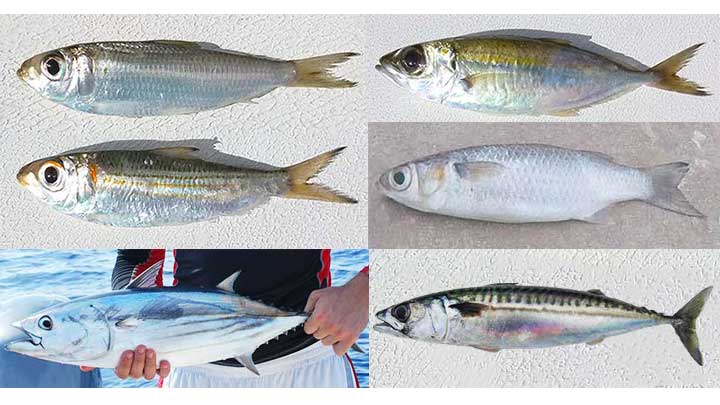
There are several ways to catch baitfish including using a cast net, minnow trap, seine net, sabiki rigs, and pinfish traps. The best type of baitfish depends on the fishing location and what the fish are naturally feeding on. Other baits including shrimp, squid will be included as types of baitfish since they are widely used as live or fresh bait.
The most common baitfish I use while fishing in saltwater includes pilchards, ballyhoo, mullet, and pinfish. It is important to have a good livewell to keep the fish alive. If you do not have a way to keep the bait alive fresh dead bait still works to catch many types of fish.
Types of Saltwater Baitfish
1. Pilchards
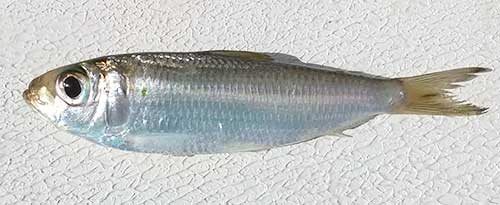
Pilchards are one of the most popular baits to use inshore, on the reef, and offshore. These baits are small enough to catch small snapper and enticing enough for large tuna, mahi-mahi, kingfish, tarpon, and most other predator fish to bite. Since the bait is small they work best with a small live bait hook or small jig. The bait will not last well in a bait pen overnight so is typically caught fresh for live bait each day. Throwing some of these overboard is a good way to bring fish near the boat. Typically it is best if they are injured or dead so they do not swim away. Do not over chum though as this will make fish less interested in your fresh baits.
These baitfish are caught for bait using a cast net. They swim in large schools so it is common to catch 100 plus fish in one cast. Pilchards do not typically eat standard chum so using sabiki rids or pinfish traps does not work. A very similar fish called a greenback can be caught with a sabiki rig. Greenbacks or greenies are slightly larger when fully grown. It is best to catch the bait with a cast net early in the morning when these baits are flicking on the surface. Looking for diving birds is a good way to locate the bait.
2. Scaled Sardines, Threadfin Herring
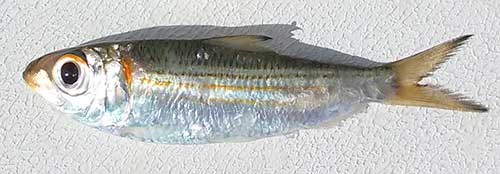
Scaled sardines are what we usually refer to as scalies. These baits are typically caught inner mixed with pilchards and threadfin herring when using a cast net. Scaled sardines are usually 3-5 inches in length and work well as live bait. These are called scalies as you will notice the scales come off easily, which is not ideal for live bait. Even though some scales come off the bait should stay alive in the Livewell for a full day of fishing.
3. Ballyhoo
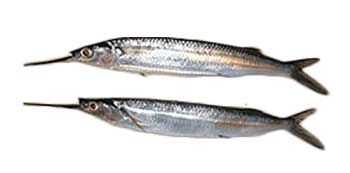
Ballyhoo is one of the most common baits to use when offshore fishing. In most cases, the bait is not alive but is trolled or pitched to catch mahi-mahi, tuna, sailfish, marlin, and wahoo. When trolling it is common to add a skirt to the bait to make it run straight more easily and also give it a bigger profile. It can be trolled without a skirt which is called naked ballyhoo. When pitching baits a full or chunked ballyhoo can be used to cast the bait near mahi-mahi.
Ballyhoo will show up in chum lines inshore and on the reef. This type of bait can be caught with a sabiki rig, small bait hook, cast net, or a specifically designed net called The BallyHoop. If you catch fresh ballyhoo while fishing it can be used as live bait. Fresh ballyhoo does stay better longer than frozen ballyhoo. It is common to salt the bellies of frozen ballyhoo to prevent the belly from washing out as quickly. Once the belly breaks apart the bait is more likely to spin and not run straight.
4. Mullet
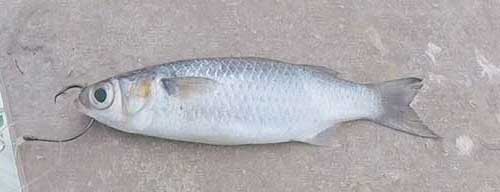
Mullet is a very good bait to use inshore. It is a very popular bait when fishing for tarpon. Other target species that mullet is good to use for bait include barracuda, sharks, redfish, and bluefish. When fishing for tarpon live mullet and fresh dead mullet both work well. It is common to cut off the tail and butterfly the fillets for the back of the fish when using dead mullet. A thin circle hook in the front lip is a good way to hook the fish. The bait should be suspended from a lightweight float in most cases when fishing inshore.
Mullet are typically caught with a cast net. In the shallows, mullet is easier to catch than in deep water. When cast netting in deepwater a large fast sinking net is needed. Finger millet 2-4 inches in length is better for small fish while large mullet can be good for catching large tarpon. Most people say mullet can not be caught using a rod and reel. However, mullet can actually be caught on a hook using small pieces of bread.
In the video above I am catching mullet with a 6-foot radius cast net. The mullet are caught in shallow water and in deep water when the fish are near the surface. Cast net placement is very important as mullet swim very fast a can evade nets that are not thrown correctly.
5. Bunker Menhaden
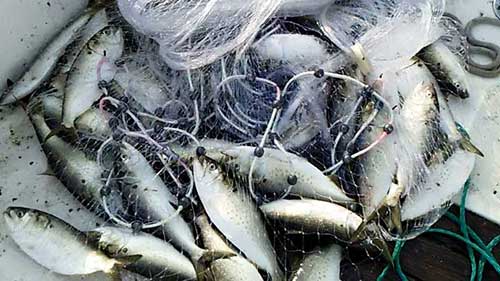
Menhaden is more commonly called bunker. This is baitfish found in large schools along the east coast of the United States. Most people use bunker to fish for striped bass and bluefish. It is also a good bait for weakfish, sharks, tuna, and small peanut bunker can be used for sea bass and fluke. Humpback whales and dolphins also feed on bunker so be on the lookout for these animals when fishing as well.
Bunker feed of plankton and the two ways they are caught are with a cast net or a snagging rig. If you just need a few fresh baits a snagging rig is an effective way to catch them. Find a school, cast the line, and pull back on the fishing rod like you are aggressively vertical jigging. Once a bunker is snagged it can sink and be used as bait right there. It can also be reeled in and placed on a circle hook. If lots of bunker is needed for a long fishing trip using a cast net is the way to catch them.
In the video above I am catching bunker with a 10-foot radius cast net. The method is to back over the school with the boat and then throw the net when the fish are marked on the fish finder. This is a good way to catch lots of large adult bunker in just one throw. Juvenile or peanut bunker are caught in inshore waters, inlets, and harbors.
6. Goggle Eyes
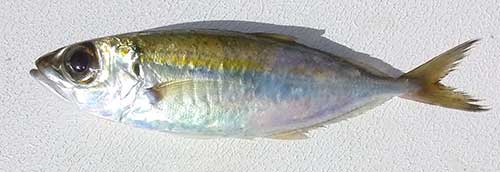
Goggle eyes are one of the most expensive and effective baitfish. This bait sells for between $3 and $10 a fish. It is in high demand during sailfish tournaments and winter sailfish season in Florida. These are also great batis to use for fishing for mahi-mahi, large tuna, and wahoo. The bait can be bridled onto the hook to last a long time. If pitching directly to a fish goggle eyes are hooked in the upper or lower back of the fish where the bait will not be able to swim away as quickly.
Fishing for goggle eyes is typically done at night with a baited sabiki rig or small bait hooks. This fish has large eyes and feeds at night. Goggle Eyes can also be caught during the day with a cast net but are hard to catch consistently. These fish can be kept in a large bait pen and use for the next few days. Don’t put them with too many other fish though or they will die quickly.
7. Herring
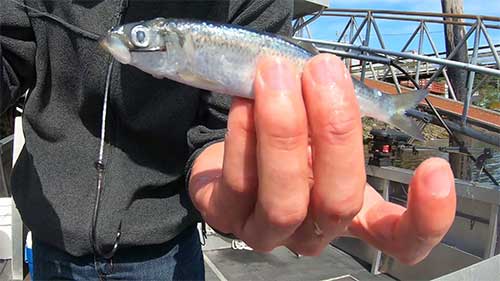
Herring is a very popular bait in both the North Atlantic and North Pacific oceans. In Alaska, Washington, Oregon, and California this is a good bait to catch salmon, halibut, and rockfish. When fishing for salmon herring is either trolled or mooched. The bait is hooked onto a rig with two snelled hooks. The herring is hooked in a way that makes it spin in the water. Typically when trolling a spinning bait will not catch fish but for salmon, this is the technique. Some anglers prefer to cut the head off and use plug cut herring. Properly hooking whole herring works just as well and is easier.
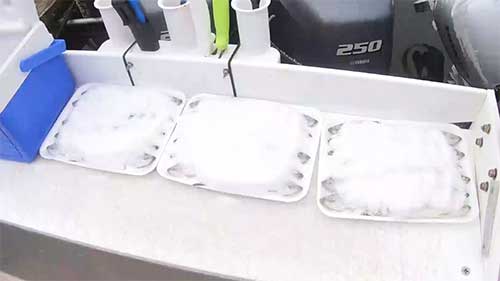
Herring come in flats with about 12 frozen herring in each package. It is common to salt the herring so that it is a tougher bait. This is smaller green label herring. Blue label herring is a bit bigger and then full-size herring can be purchased in large boxes. Full-size herring is good halibut bait but is a bit too large for salmon trolling.
Herring are typically caught by commercial fishermen using purse seiner boats. Cast nets can work but only Alaska residents can throw a cast net to catch bait. Sabiki rigs also work well to catch live herring. Live bait is rarely used in Alaska because all the target species will easily bite dead bait. Catching your own bait is a way to save some money and can be fun.
In the video above I show how to use herring for bait to mooch for salmon. This is also an effective way to catch rockfish and halibut. Herring are hooked up the same way when trolling for salmon.
8. Sardines
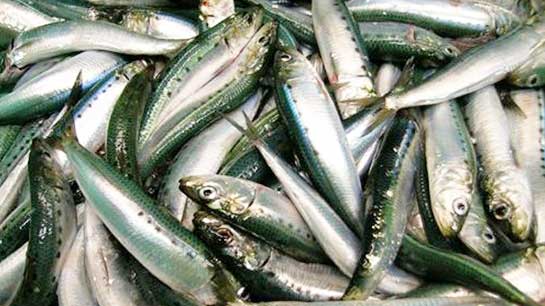
Image Source: Wikimedia Commons.
There are Spanish sardines in Florida but when most people say sardines they are referring to the pacific baitfish. This fish swims in very large schools and are prey for dorado, mahi-mahi, tuna, marlin, sharks, sea lions, whales, and dolphins. Sardines make good bait when fishing offshore or on the bottom.
Sardines are typically caught using large nets. Sabiki rigs can also be used to catch sardines. Many people think of canned sardines when hearing the word sardines as this is also a popular fish to each. Canned sardines do not make a good bait though cause they are mushy and do not stay on the hook well. They can be used as chum or mixed in with dough baits to add scent.
9. Sand Lance, Sand Eel, Needlefish
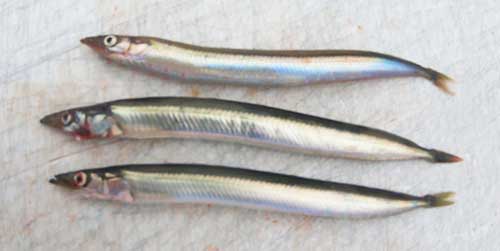
Sand lance are also called sand eels and needlefish. These fish are located in both the north pacific ocean and the North Atlantic ocean. In the pacific ocean large schools of sand lance conjugate on sand flats and gravel flats. I pulled the three sand lance shown above out of the stomach of a king salmon in Sitka Alaska. When there are not herring around sand lance makes up the majority of what is found in the stomach of early summer salmon. Sand lance are also food for halibut, rockfish, and cod.
In the Atlantic ocean, it is also common to find large schools of sand lance which are often called sand eels. This is a type of baitfish and not an actual eel. An eel also makes good bait for many types of fish. In the North Atlantic, it is common to use swim jigs that looks like sand eels when fishing. Diamond jigs are another good imitation. Sand eel imitations work well to catch striped bass, bluefish, weakfish, sea bass, and flounder.
It is not common for people to catch sand lance and use them for bait. Rather anglers troll or jig with lures that look like a sand lance. In the video above I show how to troll with downriggers. The two best baits to troll with are herring or sand lace imitations. Sand lance imitations are hoochies or flies. I like trolling sand lance imitations near the bottom but large schools of sand lance will swim at all water depths.
10. Cigar Minnow
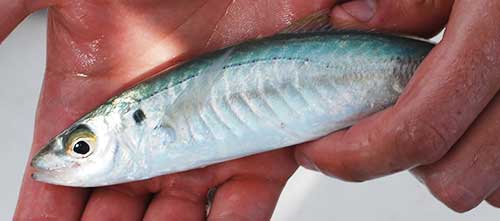
Cigar minnows work as a very good bait on the reef and offshore. These are fished vary similar to goggle eyes when fishing for mahi-mahi, tuna, sailfish, and marlin. This is a hearty bait that keeps well in the livewell. It is also a large enough bait that it can be bridled onto a hook. Cigar minnows can be used on the reef to catch, barracuda, kingfish, cero mackerel, large snapper, grouper, jacks, and amberjacks.
There are two common ways to catch cigar minnows with a cast net or with sabiki rigs. When using a cast net chum is heavily used to get a large number of fish in one area. Chum balls mixed with sand are thrown in just before throwing the net. A commonplace to fish for cigar minnows is in grass flats in about 20 feet of water.
11. Silversides, Glass Minnows, Spearing

Image Source: Virginia Institute of Marine Science.
Silversides are also called glass minnows and spearing. This is a common baitfish along the entire Atlantic coast of the United States. I have seen them in large numbers in the flats in Florida, and off Cape Cod in Massachusetts. Also when fishing in New Jersey spearing are baits commonly given out on fishing charter boats when fishing for fluke. Silversides are small fish that should be used with small hooks. Using real spearing is good as the bait is scented which helps to get fish to bite. The issue is the bait can come off the hook easily. That is why scented artificial baits luke gulp has an advantage in some cases. Spearing is a good bait for fluke, flounder, striped bass, snapper bluefish, and sea bass.
These baits can not be caught on a hook. Using a cast net with small 3/16 inch mesh would be a good way to catch these for fresh bait. It is common to catch them off the beach. A seine net would also work in shallow water. A minnow trap may work to catch silversides but I have not tried to catch them this way. If you do not have fresh silversides a small swimbait, power minnow, gulp minnow, or thin spoon are all good imitation lures.
12. Mackerel

Mackerel baitfish are common to catch in the North Atlantic and South Pacific oceans. This is a fish that can be kept to eat or used for bait. There are many types of mackerel such as king mackerel, Spanish mackerel, cero mackerel, and wahoo are even in the mackerel family. For bait though anglers are talking about gree-back mackerel. Mackerel are a food source for tuna, marlin, sharks, sea lions, and birds.
The best way for sport fishermen to catch mackerel is with sabiki rigs. Cast nets could work if you know a good location to target them. Once caught mackerel can be bridled to use as live bait or cut into chunks. Mackerel will say alive in a large live well for a day of fishing. I have caught mackerel on sabiki rigs in Maine and Massachusetts.
13. Pinfish
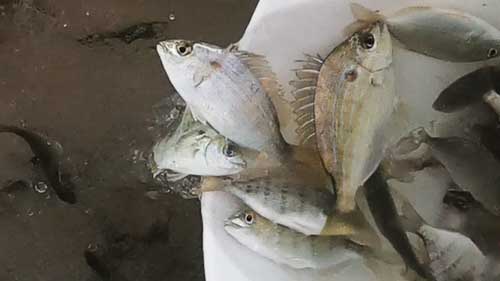
Pinfish reminds me a lot of bluegill or sunfish which are common freshwater baits. However, pinfish live in the ocean and are much more effective bait. Lots of predator fish will eat pinfish. Pilchards and mullet are typically my go-to baits when fishing in the ocean. Pinfish are the backup bait if it will be to time-consuming to catch the other bait. I like using smaller pinfish the best and they are actually a really good live bait. Target species when fishing with pinfish include tarpon, sharks, mackerel, barracuda, large snapper, grouper, jacks, amberjacks, and even sailfish. The bait is usually fished near the bottom or suspended on a float near the surface.
The best way to catch pinfish is with a pinfish trap. This type of trap is set out with chum inside overnight. When the trap is checked in the morning it will be full of pinfish if it was placed in a good location. The best thing about pinfish is they are really hardy fish. They will keep in a bait pen for weeks as long as they are fed. Pinfish will eat almost anything and we usually feed them fish scraps.
14. Flying Fish
Flying fish are one of my favorite fish to see when on the ocean. Chances are the water is a deep blue and the sun is shining. Most of the flying fish seen are just being spooked by the boat and the fish fly out of the water cause the boat scares them. If you are on the water at night flying fish are also scared of spotlights and that can make them fly. Flying fish are difficult to catch and use for bait but flying fish imitation baits and lures are commonly used. Flying fish can be caught with a small hook and a small piece of fresh bait.
Flying fish are most well known for being prey for mahi-mahi and frigate birds. The frigate birds follow the mahi-mahi and wait for them to chase the flying fish into the air where they have a chance of catching the fish. frigatebirds can not land on or enter the water so the fish must be scooped up right at the surface or in the air. Anglers fishing for mahi-mahi look for frigate birds that are following mahi-mahi so they know where to fish. Tuna, marlin, wahoo, and sailfish will also eat flying fish. The video above shows mahi-mahi and frigatebirds chasing down and trying to catch flying fish.
15. Bonito or Small Tuna
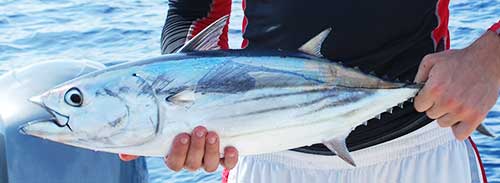
Bonito are typically caught while trolling small skirt baits. If you see tuna birds working near the surface chances are there are tuna or bonito around. A bonito has dark-read bloody meat that is not very good to eat but makes great bait. Small bonito have lighter meat and is actually a popular fish to eat. Small yellowfin tuna, skipjack tuna, and bonito can be used for bait to catch wahoo, king mackerel, large tuna, sharks, and marlin.
If you catch a bonito it is good to save for bait for several reasons. The fish can be filleted and used to make bonito strips for trolling. It can also be cut up and used for chunk bait. Chunks of bonito meat work great to catch mahi-mahi, snapper, barracuda, tarpon, and sharks. It can also be placed in a pinfish trap or feed to pinfish.
In the video above I show how to catch bonito and tuna while trolling. Baits used include Billy Baits Mini Turbo Slammer and C and H little stubbies. This was filmed in the Florida Keys but this technique should work to catch small tuna species everywhere.
16. Shrimp
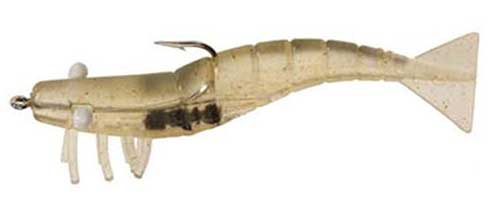
If you fish in the ocean you probably know that live shrimp is one of the most consistent ways to catch many types of fish. A live shrimp can catch a 3-ounce snapper or a 100-pound tarpon. I use shrimp most often on the reef. Depending on the current will depend on how much weight should be used, typically between zero and 0.25 ounces is best. This will catch all types of fish including yellowtail snapper, mangrove snapper, grouper, jacks, grunts, houndfish, redfish, ladyfish, pompano, permit, bluefish, and tarpon.
Shrimp can be caught using a cast net if you know where shrimp are located. It is more common to let shrimp boats catch them and then buy live shrimp from the bait store. Dead shrimp works well as long as it is super fresh. Old smelly shrimp is going to catch fewer fish in most cases. Unless you are targeting saltwater catfish which love dead smelly shrimp. Shrimp will also work offshore to catch mahi-mahi tripletail.
17. Squid
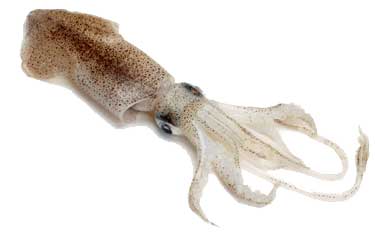
Squid is another one of the best baits for fishing. Most squid is bought frozen and used whole or cut up into small pieces. If you do not know what bait to use chances are squid will work. Personally, I really like to use squid to fish for croakers, mahi-mahi, tripletail, and halibut. It is also good bait to catch swordfish, tuna, billfish, snapper, fluke, flounder, grouper, tilefish, sharks, and most other ocean fish species.
If you mark a school of squid there are hook snaggers that can be used to catch them. I do not know many people that actually catch their own squid for bait though. Sometimes when snorkeling or scuba diving I will see some squid on the reef. Not the large schools which are usually in deep water during the day. There are many imitation squid baits that work great when trolling offshore.
Captain Cody has worked on charter fishing boats in the Florida Keys, Virgin Islands, and Alaska. Growing up in Pennsylvania Cody has also done extensive freshwater fishing including bass fishing tournaments. Cody strives to provide detailed information about the best fishing gear and tactics to help both novice and experienced anglers have a more productive and enjoyable time on the water. Cody also has a background in aerospace engineering and neuroscience but really only takes pride in being good at one thing and that is fishing!
